light Acura CL 2002 Owner's Manual
[x] Cancel search | Manufacturer: ACURA, Model Year: 2002, Model line: CL, Model: Acura CL 2002Pages: 335
Page 8 of 335
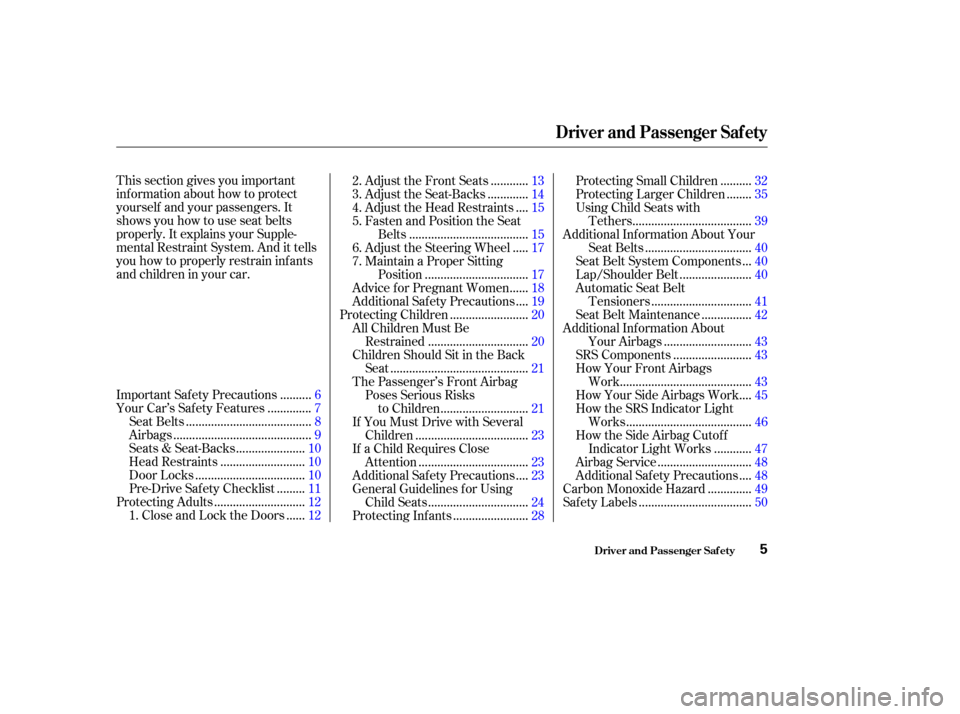
This section gives you important
inf ormation about how to protect
yourself and your passengers. It
shows you how to use seat belts
properly. It explains your Supple-
mental Restraint System. And it tells
you how to properly restrain inf ants
andchildreninyourcar..........
Important Safety Precautions . 6
.............
Your Car’s Saf ety Features . 7
.......................................
Seat Belts .8
...........................................
Airbags .9
.....................
Seats & Seat-Backs .10
..........................
Head Restraints .10
..................................
Door Locks .10
........
Pre-Drive Saf ety Checklist . 11
............................
Protecting Adults .12
.....
1. Close and Lock the Doors . 12 ...........
2. Adjust the Front Seats . 13
............
3. Adjust the Seat-Backs . 14
...
4. Adjust the Head Restraints . 15
5. Fasten and Position the Seat .....................................
Belts .15
....
6. Adjust the Steering Wheel . 17
7. Maintain a Proper Sitting ................................
Position .17
.....
Advice f or Pregnant Women . 18
...
Additional Safety Precautions . 19
........................
Protecting Children .20
All Children Must Be ...............................
Restrained .20
Children Should Sit in the Back ...........................................
Seat .21
The Passenger’s Front Airbag Poses Serious Risks ...........................
to Children .21
If You Must Drive with Several ...................................
Children .23
If a Child Requires Close ..................................
Attention .23
...
Additional Safety Precautions . 23
General Guidelines f or Using ...............................
Child Seats .24
.......................
Protecting Inf ants .28 .........
Protecting Small Children . 32
.......
Protecting Larger Children . 35
Using Child Seats with .....................................
Tethers .39
Additional Inf ormation About Your .................................
Seat Belts .40
..
Seat Belt System Components . 40
......................
Lap/Shoulder Belt .40
Automatic Seat Belt ...............................
Tensioners .41
...............
Seat Belt Maintenance . 42
Additional Inf ormation About ...........................
Your Airbags .43
........................
SRS Components .43
How Your Front Airbags .........................................
Work .43
...
How Your Side Airbags Work . 45
How the SRS Indicator Light .......................................
Works .46
How the Side Airbag Cutof f ...........
Indicator Light Works . 47
.............................
Airbag Service .48
...
Additional Safety Precautions . 48
.............
Carbon Monoxide Hazard . 49
...................................
Saf ety Labels .50
Driver and Passenger Saf ety
Driver and Passenger Saf ety
5
Page 11 of 335

In addition, most states and all
Canadian provinces require you to
wear seat belts.
When properly worn, seat belts:Help protect you in almost every
type of crash, including f rontal,
side, and rear impacts and
rollovers.
Foryoursafety,andthesafetyof
your passengers, your car is
equipped with seat belts in all seating
positions.
Seat belts are the single most
effectivesafetydeviceforadultsand
larger children. (Inf ants and smaller
children must be properly restrained
in child seats.)
Not wearing a seat belt properly
increases the chance of serious
injury or death in a crash, even
though your car has airbags.
Your seat belt system also
includes a light on the
instrument panel to remind you and
your passengers to f asten your seat
belts.
Keep you connected to the vehicle
so you can take advantage of the
vehicle’s built-in saf ety f eatures.
These saf ety f eatures are designed
to reduce the severity of injuries in a
crash. However, you and your
passengers can’t take f ull advantage
of these saf ety f eatures unless you
remain sitting in a proper position
and
In f act, some saf ety
f eatures can contribute to injuries if
they are not used properly.
Driver and Passenger Saf ety
Your Car’s Saf ety Features
Seat Belts
Why Wear Seat Belt s
always wear your seat belts
properly.
8
Not wearing a seat belt properly
increases the chance of serious
injury or death in a crash, even
if you have airbags.
Be sure you and your
passengers always wear seat
belts and wear them properly.
Page 15 of 335

The f ollowing pages provide
instructions on how to properly
protect the driver and other adult
occupants.
These instructions also apply to
children who have outgrown child
seats and are large enough to wear
lap/shoulder belts. (See page f or
important additional guidelines on
how to properly protect larger
children.)For security, locked doors can
prevent an outsider f rom
unexpectedly opening a door when
you come to a stop.
See page f or how to lock the
doors.
For saf ety, locking the doors reduces
the chance that a passenger,
especially a child, will open a door
while the car is moving and
accidentally f all out. It also reduces
the chance of someone being thrown
out of the car during a crash. Your car has a door monitor light on
the instrument panel to indicate
when a specif ic door is not tightly
closed. Af ter everyone has entered the car,
be sure the doors are closed and
locked.
35 77
Driver and Passenger Saf ety
Protecting Adults
Introduction
Close and L ock the Doors
1.
12
Page 43 of 335
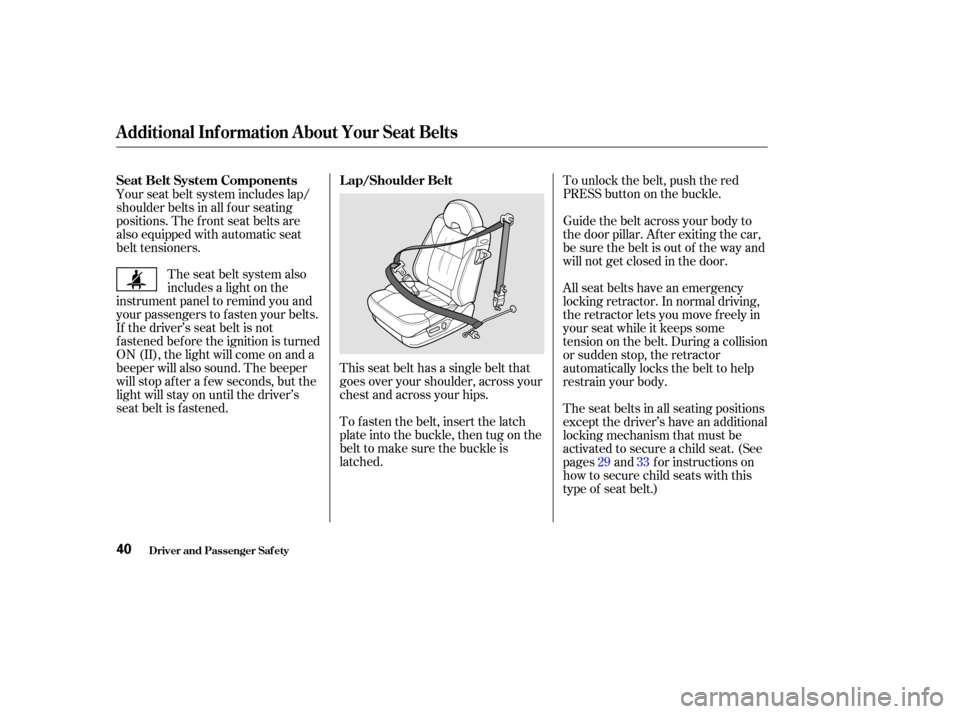
This seat belt has a single belt that
goes over your shoulder, across your
chest and across your hips.To unlock the belt, push the red
PRESSbuttononthebuckle.
To fasten the belt, insert the latch
plate into the buckle, then tug on the
belt to make sure the buckle is
latched.
The seat belt system also
includes a light on the
instrument panel to remind you and
your passengers to f asten your belts.
If the driver’s seat belt is not
fastened before the ignition is turned
ON (II), the light will come on and a
beeper will also sound. The beeper
will stop af ter a f ew seconds, but the
light will stay on until the driver’s
seat belt is f astened. Your seat belt system includes lap/
shoulder belts in all f our seating
positions. The f ront seat belts are
also equipped with automatic seat
belt tensioners. Guide the belt across your body to
the door pillar. Af ter exiting the car,
be sure the belt is out of the way and
will not get closed in the door.
All seat belts have an emergency
locking retractor. In normal driving,
the retractor lets you move f reely in
your seat while it keeps some
tension on the belt. During a collision
or sudden stop, the retractor
automatically locks the belt to help
restrain your body.
The seat belts in all seating positions
except the driver’s have an additional
locking mechanism that must be
activated to secure a child seat. (See
pages and f or instructions on
how to secure child seats with this
type of seat belt.)29 33
Driver and Passenger Saf ety
Additional Inf ormation About Your Seat Belts
Seat Belt System Components L ap/Shoulder Belt
40
Page 44 of 335
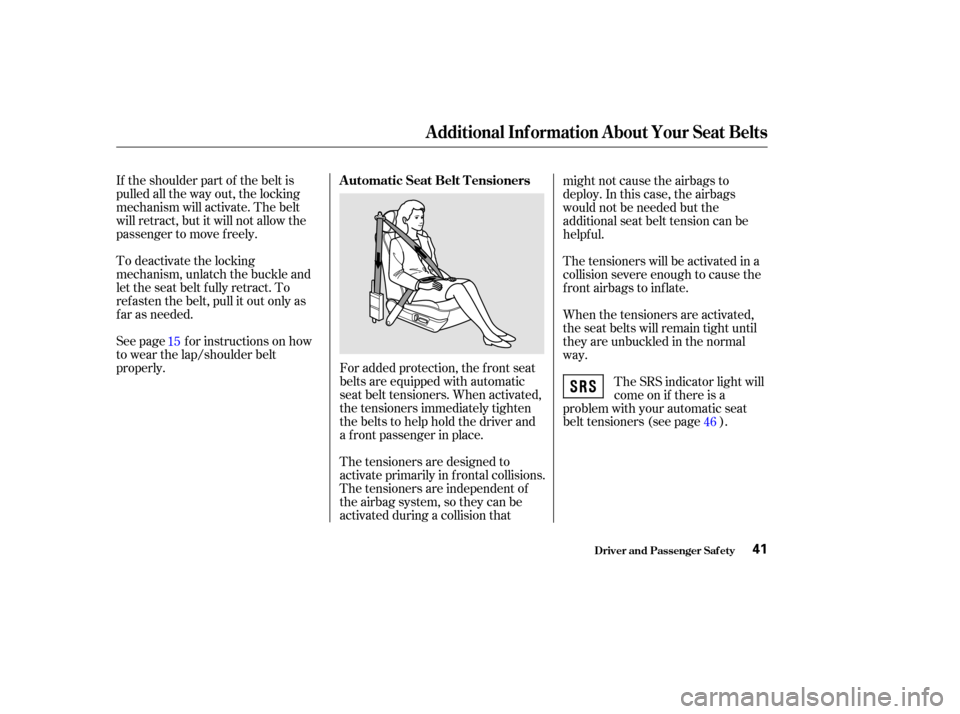
If the shoulder part of the belt is
pulled all the way out, the locking
mechanism will activate. The belt
will retract, but it will not allow the
passenger to move f reely.
To deactivate the locking
mechanism, unlatch the buckle and
let the seat belt f ully retract. To
ref asten the belt, pull it out only as
f ar as needed.
See page f or instructions on how
to wear the lap/shoulder belt
properly.For added protection, the f ront seat
belts are equipped with automatic
seat belt tensioners. When activated,
the tensioners immediately tighten
the belts to help hold the driver and
a f ront passenger in place.
The tensioners are designed to
activate primarily in f rontal collisions.
The tensioners are independent of
the airbag system, so they can be
activated during a collision that might not cause the airbags to
deploy. In this case, the airbags
would not be needed but the
additional seat belt tension can be
helpf ul.
The tensioners will be activated in a
collision severe enough to cause the
f ront airbags to inf late.
The SRS indicator light will
come on if there is a
problem with your automatic seat
belt tensioners (see page ). When the tensioners are activated,
the seat belts will remain tight until
they are unbuckled in the normal
way.
15
46
Driver and Passenger Saf ety
Additional Inf ormation About Your Seat Belts
A utomatic Seat Belt T ensioners
41
Page 46 of 335
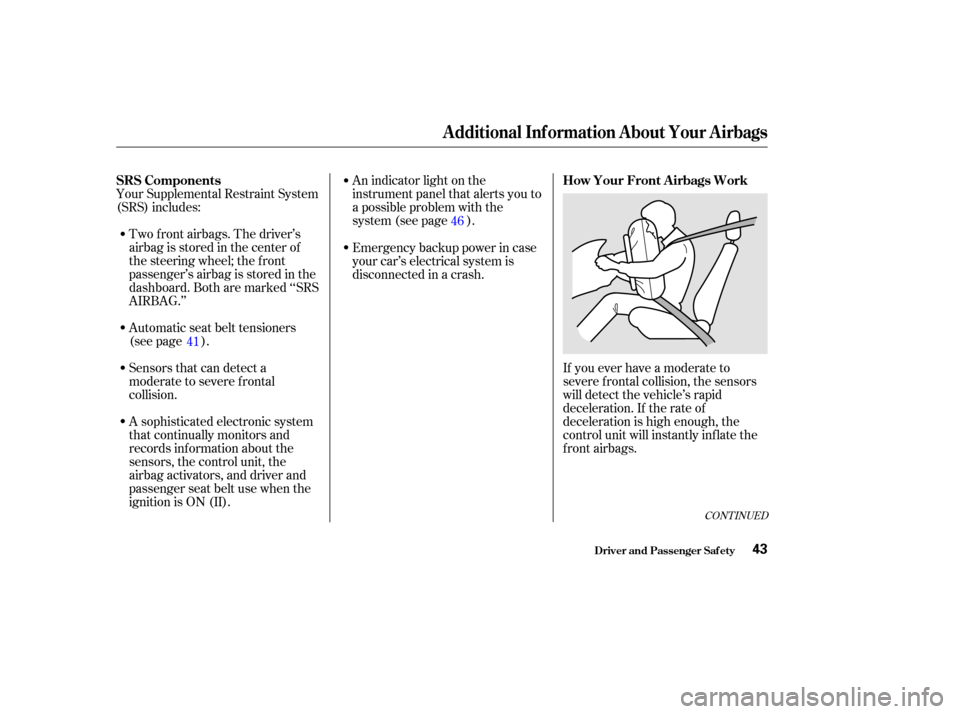
Your Supplemental Restraint System
(SRS) includes:An indicator light on the
instrument panel that alerts you to
a possible problem with the
system (see page ).
Two f ront airbags. The driver’s
airbag is stored in the center of
the steering wheel; the f ront
passenger’sairbagisstoredinthe
dashboard. Both are marked ‘‘SRS
AIRBAG.’’
Sensors that can detect a
moderate to severe frontal
collision. Automatic seat belt tensioners
(see page ). Emergency backup power in case
your car’s electrical system is
disconnected in a crash.
If you ever have a moderate to
severe f rontal collision, the sensors
will detect the vehicle’s rapid
deceleration. If the rate of
deceleration is high enough, the
control unit will instantly inf late the
f ront airbags.
A sophisticated electronic system
that continually monitors and
records inf ormation about the
sensors, the control unit, the
airbag activators, and driver and
passenger seat belt use when the
ignition is ON (II). 41
46
CONT INUED
SRS Components
How Your Front A irbags Work
Driver and Passenger Saf ety
Additional Inf ormation About Your Airbags
43
Page 49 of 335

If the light comes on at any other
time, or does not come on at all, you
should have the system checked by
your dealer. For example:If the SRS indicator light does not
come on after you turn the ignition
ON (II).
If the light stays on after the
engine starts.
If the light comes on or f lashes on
andoff whileyoudrive.
Thepurposeof theSRS
indicator light is to alert
you to a potential problem with your
f ront airbags. This light will also
alert you to a potential problem with
your automatic seat belt tensioners
(page );oryoursideairbagsor
passenger’s side airbag automatic
cutof f system (page ).
When you turn the ignition ON (II),
this indicator will light brief ly then
go out. This tells you that the system
is working properly. If you see any of these indications,
your f ront or side airbags may not
deploy, your passenger’s side airbag
automatic cutoff system may not
work properly, or your seat belt
tensioners may not work when you
need them. See your Acura dealer as
soon as possible.
41
47
How the SRS Indicator L ight
Works
Additional Inf ormation About Your Airbags
Driver and Passenger Saf ety46
Ignoring the SRS indicator light
can result in serious injury or
death if the airbags, cutoff
system, or tensioners do not
work properly.
Have your vehicle checked by a
dealer as soon as possible if
the SRS light alerts you to a
potential problem.
Page 50 of 335

This light alerts you that
the passenger’s side airbag
has been automatically shut off. If a small-statured adult leans
sideways, or larger adult slouches
and leans sideways into the
deployment path of the side airbag,
the system may also shut of f the side
airbag.A f ront seat passenger should not
use a cushion or other object as a
backrest. It may prevent the cutof f
system f rom working properly.
When you turn the ignition ON (II),
the indicator should light brief ly and
goout(seepage ).Ifitdoesn’t
light, stays on, or comes on while
driving without a passenger in the
f ront seat, have the system checked.
If the side airbag cutof f indicator
light comes on, you should have the
passenger sit upright. Once the
passenger is out of the deployment
path of the side airbag, the system
will turn the airbag back on and the
light will go out.
To reduce the risk of injury f rom an
inf lating side airbag, your car has an
automatic cutoff system for the
passenger’s side airbag. If does not mean there is a problem
with your side airbags. It means that
thesideairbagcutoff systemhas
activated to prevent the side airbag
f rom deploying.
Although Acura does not encourage
children to ride in the f ront seat, this
system is designed to shut of f the
side airbag if a child leans sideways
and the child’s head is in the side
airbag deployment path. 56
Driver and Passenger Saf ety
Additional Inf ormation About Your Airbags
How the Side Airbag Cutof f
Indicator L ight Works
47
Page 51 of 335

Your f ront and side airbag systems
are virtually maintenance-f ree, and
there are no parts you can saf ely
service. However, you must have
your car serviced if :Take your car to an
authorized Acura dealer as soon as
possible. If you ignore this
indication, the airbags might not
inf late when you need them. Together, airbags and
seat belts provide the best
protection.
Tampering could cause
the airbags to deploy, possibly
causing very serious injury. See page f or f urther inf ormation
and precautions relating to your
airbags.Improperly
replacing or covering f ront seat-
back covers can prevent your side
airbags f rom inf lating during a
collision.
If rain or spilled water
soaks into a seat-back, it can
prevent the side airbag system
f rom working properly.
Any
airbag that has deployed must be
replaced along with the control
unit, automatic seat belt
tensioners and other related parts.
Do not try to remove or replace
anyairbagbyyourself.Thismust
be done by an Acura dealer or a
knowledgeable body shop. 170
Additional Inf ormation About Your Airbags
Airbag Service
Additional Saf ety Precautions
T he SRS indicat or light alert s you
t o a problem. Donotattempttodeactivateyour
airbags.
Do not t amper wit h airbagcomponent s or wiring f or anyreason. Do not cover or replace f ront seat -
back covers wit hout consult ing anAcura dealer.
Do not expose t he f ront seat -backs to water.
Your airbags ever inf late.
Driver and Passenger Saf ety48
Page 54 of 335
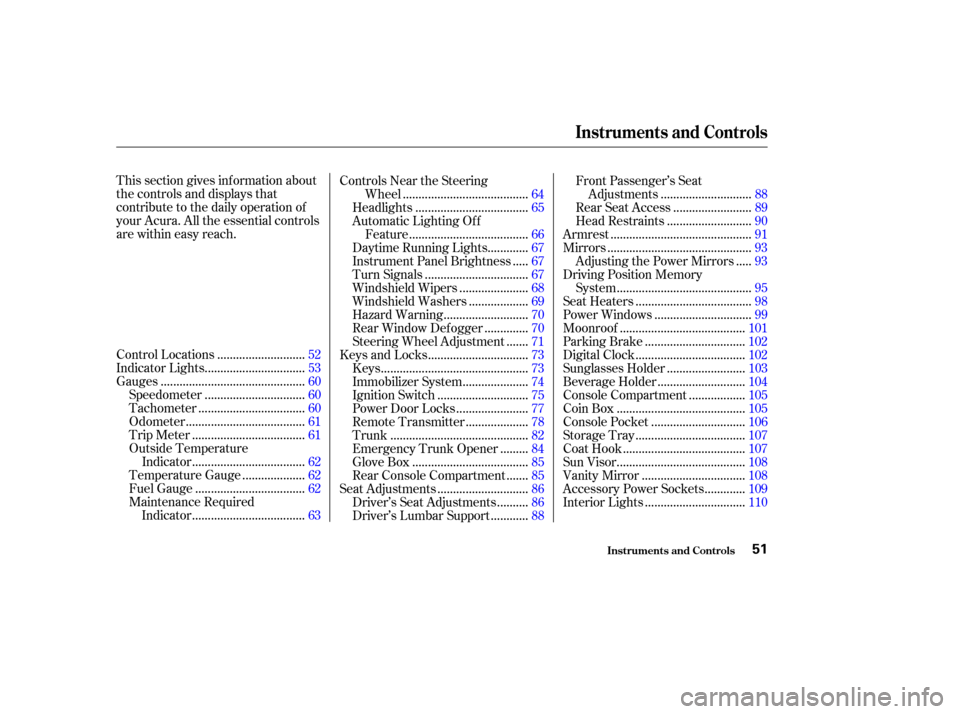
This section gives inf ormation about
the controls and displays that
contribute to the daily operation of
your Acura. All the essential controls
are within easy reach............................
Control Locations .52
...............................
Indicator Lights .53
.............................................
Gauges .60
...............................
Speedometer .60
.................................
Tachometer .60
.....................................
Odometer .61
...................................
Trip Meter .61
Outside Temperature ...................................
Indicator .62
...................
Temperature Gauge . 62
..................................
Fuel Gauge .62
Maintenance Required ...................................
Indicator .63 Controls Near the Steering
.......................................
Wheel .64
...................................
Headlights .65
Automatic Lighting Off .....................................
Feature .66
............
Daytime Running Lights . 67
....
Instrument Panel Brightness . 67
................................
Turn Signals .67
.....................
Windshield Wipers .68
..................
Windshield Washers . 69
..........................
Hazard Warning .70
.............
Rear Window Def ogger . 70
......
Steering Wheel Adjustment . 71
...............................
Keys and Locks .73
..............................................
Keys .73
....................
Immobilizer System . 74
............................
Ignition Switch .75
......................
Power Door Locks .77
...................
Remote Transmitter . 78
...........................................
Trunk .82
........
Emergency Trunk Opener . 84
....................................
Glove Box .85
......
Rear Console Compartment . 85
............................
Seat Adjustments .86
.........
Driver’s Seat Adjustments . 86
...........
Driver’s Lumbar Support . 88Front Passenger’s Seat
............................
Adjustments .88
........................
Rear Seat Access .89
..........................
Head Restraints .90
............................................
Armrest .91
.............................................
Mirrors .93
....
Adjusting the Power Mirrors . 93
Driving Position Memory ..........................................
System .95
....................................
Seat Heaters .98
..............................
Power Windows .99
.......................................
Moonroof .101
...............................
Parking Brake .102
..................................
Digital Clock .102
........................
Sunglasses Holder .103
...........................
Beverage Holder .104
.................
Console Compartment . 105
........................................
Coin Box .105
.............................
Console Pocket .106
..................................
Storage Tray .107
......................................
Coat Hook .107
........................................
Sun Visor .108
................................
Vanity Mirror .108
............
Accessory Power Sockets . 109
...............................
Interior Lights .110
Instruments and Controls
Inst rument s and Cont rols51